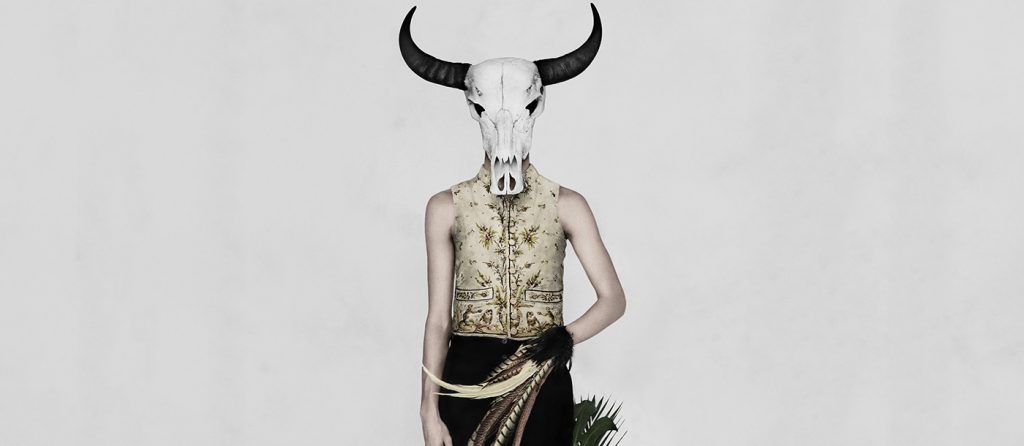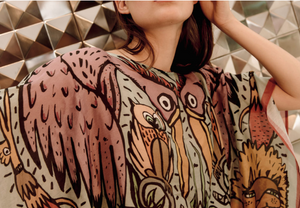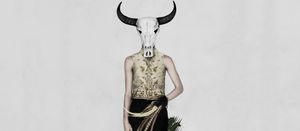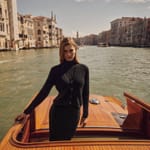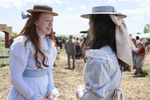When AJ Met Edwina at the V&A Museum

Reader, What does the future of fashion look like now that climate change is finally being treated as a threat to life on earth? Can you imagine a world where there is no intoxicating, beguiling nature left to plunder, adorn and inspire our collective, never-ending appetite for new clothes?
In this long-form feature and filmed V&A documentary interview, I examine fashion’s dirty past and the ingenious, state of the art, circular and sustainable fashion and textile innovations which have the power to transform the fashion industry if we act decisively and collectively now.
The special filmed part of this in-depth feature is with Edwina Ehrman, historian, and curator of Fashioned from Nature at the V & A Museum.

The exhibition asks an important question of our time. How can we continue to enjoy our passion for fashion and adorn ourselves in new clothing, without destroying the beauty and infinite variety of nature? Can icons like Emma Watson, Sienna Miller, and Leonardo di Caprio influence a generation to change the way they think about fashion?
Since the very beginnings of civilization, we have looked to nature to adorn ourselves, keep us warm and to captivate the senses; but that is also the problem. Encouraged by the idea of novelty, and the desire for greater, and greater profits, the fashion industry has run rampant. Polluting it’s way from the grim Victorian cotton mills – to the glittering contemporary catwalks of Paris, London, Milan, and New York, with a twinkling, never-ending mirage of newness, novelty, excess, and celebrity razzmatazz to hide the dirty truth. And the truth is this. The fashion industry exploits both people and planet and resources, in order to fuel the idea that we have nothing to wear. But those resources are finite.
It is also true that fashion is a genius at innovation, and that is where the solution lies. We need to find a better way to enjoy and experience fashion, and perhaps, in the near future, it will be more about the experience than ownership or marriage between the two.

Of course fashion matters. It is one of the highest forms of self-expression and creativity and imagination. Where would be if we couldn’t continue to immerse ourselves in art, beauty, ideas and the desire to captivate? It is what makes us human. The good news is that we are moving on from sixty years of throwaway fashion, and the idea that we have never had it so good – to a smart circular age, where waste becomes the new gold, and we innovate to transform our post-consumer goods and rubbish into beautiful and remarkable new goods. This is where all the excitement lies in the fashion of the future – it’s all about reinvention and the circular economy.

Pioneering Ethical Fashion Journalism at You Magazine
When I first started to ask this question as a feature writer and fashion editor, I was working for Sue Peart the former editor of You Magazine between 2004-6. At the time, the magazine was a great supporter of organic food and farming, and I proposed a series of ethical fashion features, that would use icons to question how we make and consume fashion and look at new, more sustainable ways to be fashionable. I wondered if we could embrace a renewed spirit of thrift, ingenuity and make do and mend in a way our grandmothers and great-grandmothers learned how to do so well between the two great wars of the 20th Century.

Sienna Miller, star of Alfie, Factory Girl, and Cabaret, kindly agreed to be my muse for a feature with People Tree, the pioneering Fair-trade Fashion house. After a flurry of calls and a great deal of planning, we took off a to an exquisite Victorian garden in Surrey, with top fashion lensman, Mike Owen, to photograph Sienna in Fair-trade, organic velvet mini dresses, gauzy, handcrafted, Stevie Nicks knitwear and twinkling, boho Gatsby cloches, made by my Danish archaeologist friend Anna, who works on a loom in her sitting room. Little to did Anna know what she was letting herself in for, but more of that later!
Sienna Miller Tells the World to Buy Organic Knickers

I am now going to make a confession to you. Directing a sustainable fashion story at this time wasn’t easy. Sienna and I had to get seriously creative with a shapeless velvet skirt, which we turned into a mini boob tube dress, and teamed with a gorgeous pair of Sienna’s supine, boho suede boots. Yes, this was in the very early days of ethical fashion, and a whole lot of customization had to happen.
Of course, that is what fashion is all about. Sienna really believed in the story and she was absolutely brilliant about mucking in and making the clothes look amazing. She also told me to tell You Magazine readers to ‘buy organic knickers and change the world’ and that really started something!
People Tree Goes to Top Shop

The day after the feature came out on a Sunday, You magazine received hundreds of phone calls from readers wanting to know where they could buy the clothes, and People Tree was invited to sell in Top Top. Anna’s pale gold cloche, shot with glitter was a huge hit, and my poor friend was both delighted and bemused by the reaction, which included enough inquiries for twenties hand knitted Sienna cloches to swap archaeology for fashion. The story and interview with Sienna really helped to ignite interest in the fledgling sustainable fashion industry and in a love of upcycling and reinventing our existing clothes into exciting new clothes. The seeds had been sown.

Based on the success of the Sienna Miller feature, Sue commissioned me to do a second sustainable fashion feature. This time, I took the daughters of British rock ‘n’ royal royalty to a waste recycling centre, outside London and photographed them in experimental, upcycled couture evening gowns, against a colourful backdrop of bales of rather stinky recycled newspaper! It was just as well it was the middle of winter. Fortunately for me, our lovely rock muses firmly wanted to help save the planet and put sustainable fashion on the front page and not one of them complained about the location or the freezing temperatures.
Rock ‘n’ Roll Green Fashionistas

Fast forward to 2018, and what a long, long way we have come. Back in 2006, it took me months of detective work and dogged journalistic inquiry, to track down designers who were beginning to make elegant up-cycled fashion worthy of the rock glitterati. There was a lot of very, very bad ethical fashion around at the time and it was ugly, primitive and unwearable. Two designers who really stood out, and they are still doing exciting work today are From Somewhere and Victim London. Both were featured in this early fashion feature with David Gilmour’s daughter Sarah, Sting’s daughter Mickey and Leah Wood, the daughter of Ronnie Wood.

It is exciting to see how sustainable fashion has grown up, become a movement in the last decade, and attracted the brightest stars from our fashion universities. For make no mistake, it is great fashion that will change the world and protect our blue planet. Not bad fashion that is dull but worthy.
Fashioned from Nature proves this point. As Edwina Ehrman says, ‘we are showing good fashion here’. I would go further, and say that the fashion innovation on show at the V & A is as exciting as Dior’s New Look at the end of World War Two and the glittering 18th century manteau court dress, embroidered like a tapestry with flowers, butterflies and leaves in such intricacy and realism, it is as if the natural world has colonized the dress.

Go and see the exhibition. The future of fashion glitters with ideas which would have been unimaginable even a decade ago. Look at the star sustainable pieces and marvel at the couture craftsmanship and skill of fashion. In 1997, the mercurially brilliant Jean Paul Gaultier showed that you don’t need to kill an animal for its fur to drape oneself in its iconic beauty. You can recreate the beauty and miracle of evolution in his witty leopard gown, which fools everyone into thinking it’s real with Gaultier’s celebrated wit and irony!
Jean Paul’s Gaultier’s Leopard Couture Masterpiece

In fact, it is handcrafted to reveal all the light and shade and texture of the leopard in a thousand hours of astonishing beadwork. Then, look at Ferragamo’s orange fiber skirt and blouse, which captures the fruitfulness of Sicily, with a print of tiny oranges and figures is an innovative delight, whilst saving 600,000 tonnes of citrus waste from the fruit industry every year. While leather gets an animal-friendly makeover in the fluid, tactile beauty and movement achieved, with Mycelium mushroom leather. Your brave new world of smart, sustainable and utterly covetable fashion starts here.
Seven years ago, when I interviewed Sir David Attenborough for the launch of Frozen Planet, he told me that he was optimistic about the future, despite the challenges we face. ‘Human beings are the smartest mammals on the planet. I hope that we will innovate our way out of trouble’, he said. It seems that he was right.

Unless we want to get in a spaceship with Elon Musk and move to Mars, it is time to use our imaginations to dream up and create a super sustainable world, where nature is all around us, not a thing apart. The Fashioned from Nature exhibition proves this point. It is full of extraordinary and ingenious ideas for creating a bold new idea of fashion. The future of fashion is about new, luxurious fibres from mushrooms to citrus waste and even clothes made from recyclable paper and Emma Watson’s super sustainable Met Gala gown, made from a new polyester yarn spun from recycled plastic bottles in Italy. It is also about growing natural fibres such as cotton, flax, and silk more sustainably, using organic farming methods.
The Future of Fashion is Circular

In the near future, I have no doubt that the idea of sending a barely worn garment to landfill will be considered primitive and wasteful and those circular economy ideas will rule the roost not just in our wardrobes, but in every aspect of our lives, and our the throwaway society gives way to a new greenage of alchemy, pillar box red lipstick, and glorious reinvention.
Copyright Alison Jane Reid/Ethical Hedonist Magazine. All Rights Reserved June 2018.
Alison Jane Reid’ Fashion Documentary and this article are made possible by C&A Foundation. Support more exciting sustainable fashion journalism by sharing this article and backing our new crowdfunding project and get involved today on @Patreon here – Ethical Hedonist on Patreon
Follow us on Twitter @ethicalhedmag please share using the hashtag #EHFashfromNatureDoc
Images Copyright the V & A Museum and Alison Jane Reid/EthicalHedonistMagazine 2018.

